 When is an Indian not an Indian? When it’s an Enfield Indian, which is different from an Indian Enfield. Of course it could be a Velocette instead. Or a Vincent. We think. Sort of. Story: Ned Shaw. |
With the first of the new 100 cubic inch three-valve V-twin Indians expected to roll off the production line next January, Indian is a name which still evokes some of the strongest of responses with classic motorcyclists. Most, however, think of big side-valve V-twins and heavily valanced guards.
But, contrary to popular belief, there were a number of other badge-engineered Indians and, for 30 years between 1953 and 1983, the Indian motorcycle was kept alive by these alternative Indians. Two of the most worthwhiile efforts at creating an alternative Indian were the Redditch-built 700cc indian Enfield Chief and the delightful 500cc Clymer Indian Velocette.

Phillip Doland has five of these motorcycles among the 30+ bikes he owns: one Velo and four Enfields. He has also formed a register for owners of the Clymer machines.
Although some Indian lovers will hotly debate the point, the best shot Indian had of staying alive was through Clymer’s efforts which produced the 750 Interceptor-based Indian Enfield and Velo. And it was, inadvertently, Clymer’s involvement in Indian which has led to much of the wrangling over the current use of the name.
After starting work at the age of 14, around 1909, Clymer moved into distributing, dealing and racing the motorcycles he loved - Indians. After World War Two, he established Cycle magazine and set up a successful automotive publishing house.
Meanwhile, the British firm Brockhouse was providing motorcycles to extend the Indian range. This ultimately led to the Redditch Enfields being sold as Indian models with names like Trailblazer and Westerner.
As an aside, during this period Phil Viincent put together one prototype Indian Vincent. This employed a modified motor, which, while housed in an Indian chassis, would match other Vincent Rapides for speed.

Already supporting the ailing Indian company, from 1949 Brockhouse began financing Indian and, in 1950, bought it out completely. But, suffering from a case of excessive managerialism and a failure to develop its V-twins apace of Harley-Davidson, Indian was split into two companies, one for manufacturing and another for sales.
Unable to meet the retooling costs for a new, overhead-valve engine, the manufacturing arm, owned by Titeflex Corporation, closed in 1953. This spelled the end of the big V-twins for which Indian is best known and, according to some “purists”, was also the end of Indians as such.
| Yet Enfields were rebadged as Indians until 1959, when the Indian name was finally droppped from motorcycles altogether, although dealerships still carried the Matchless/Indian name. The prime, and last example, was the Enfiled “Chief” which sold as late as 1960. It was based on the then current 700cc twin, but fitted with all the Indian Chief paraphernalia such as 16-inch wheels and deep guards, spotlilghts and fringed saddlebags. |
Associated Motorcycles of Britian, which made AJS and Matchless, bought the Indian name in 1960. Three years later, in 1963, the US distributorship of AMC passed into the hands of the Berliner Motor Corporation and all references to the Indian name were quietly and finally removed.
Although the detail of the deal is still ambiguous - leading to much of the dispute over the ownership of the Indian name - The Indian Sales Corporation passed into Floyd Clymer’s cashed-up hands in the mid-1960’s.
It had been his plan since 1953 to resurrect the Indian name and, now that he “owned” it, he set about producing new Indians. The intention was that this would keep the name alive while he set up a new company to build machines from scratch. During 1967, Clymer took over distributorship of Freidl Munch’s NSU-powered Mammoth motorcycles and for a while marketed them as Indians. In return, Munch retooled to produce the old 750cc side-valve V-twin which was housed in a Munch chassis and labelled the Scout.
Although well received at the Motorcycle Show in 1967, only one Clymer/Munch Indian Scout was ever made.
Clymer continued to keep the Indian name alive by importing and rebadging Taiwanese minibikes, and meanwhile searched for a new basis for production. By this stage Clymer had moved away from solely American-made products and now searched the world for the best he could find.
The cutting edge of suspension and frame design was in Italy, where the small Italjet company was importing Triumph Bonneville engines and housing them in Leo Tartarini designed and built chassis. Clymer signed up Italjet and, after building prototypes using both Norton and German Horex engines, negotiated to buy engines from the fading Velocette company. Though on its last legs, the 500 Velocette was, even in 1969-70, still among the most desirable of motorcycles.
About 250 of these 500cc Velocette Indians were built and sold and were said to be better handling machines than Velos themselves. Advantages of the Velocette Indian included a better frame and suspension package than standard, 35 pounds less weight and styling which, while less “classic”, continues to stand as one of the finest pieces of late 1960’s design.
Of these, 200 went to the United States, 50 stayed in Britain, to be sold by Geoff Dodkin.
Indian Velos came in both Venom and Thruxton states of tune, pumping out a respectable 27.5 and 30.5kW respectively. A road test of an Indian Velo in 1974 described it as “very fast and good handling, and... as rare as hen’s teeth and worth a small fortune.
Clymer also resurrected the Enfield association, buying 750cc engines from Royal Enfield and housing them in the Tartarini chassis. This MkII model Enfield Interceptor engine produced a very respectable 40kW.
However, Floyd Clymer’s bid to breathe life back into Indian came late in his long and eventful life and he died, in 1970, before he could properly re-establish the marque. When Clymer died, his dream disappeared with him and the future of the Indian as a serious motorcycle came to a halt.
Almost in sympathy, Royal Enfield and Velocette closed their doors in 1971.
Minibikes and mopeds were produced by two companies bearing the Indian name until 1981, after which the once revered moniker was passed to a go-cart manufacturer.
One of the odd consequence of Clymer’s death was that when the Indian Enfield Chief stoppped production, there were about 90 Royal Enfield Interceptor II engines left over and nothing to put them in. The Rickman brothers were asked if they could do something, and produced what became theRickman Enfield.
While not an Indian in any sense, the Rickman Enfield was closely related to the Indian Enfields of the time and is a rare and unusual motorcycle in its own right. The bug of period association having bitten hard, Phillip acquired one of these very competent Rickman Enfields, sort of to act as a cousin to his two Indian Enfield Chiefs.

INDIAN "750" (45 cu. in.) ROADSTER -- This will be a lower- priced Indian than the Scout -probably about ~l,450. It will be a vertical twin OHV with 4-speed gearbox and kick starter. Standard equipment will include twin-disc front brake, Ceriani forks, 5-way shocks and twin-drum rear brake (all Ceriani), Bosch headlight with VDO speedometer, Borrani aluminun alloy rims, Magura controls with cross braced bars. Indian red with black frame. Deliveries to start about June 1968. Price abbut ~I,450.
INDIAN CHIEF (61 cu. in. - lOOOcc) -- Side-valve V-Twin design engine such as used in the Scout but with more power and speed, as the bore will be larger with the same 31/2" stroke as the Scout. Four cams, electric starter and all other Scout features. Price about ~2,000.
INDIAN SUPER CHIEF (61 cu. in. - lOOOcc) -- Six valves in head, overhead camshaft, four cams, electric starter. Ready in January 1969. Price about ~2,750.
Thus it can be seen that we have a unique line of Indians coming, some ready in early Fall of 1968, and all ready soon after the first of the year"
He had contacted Freidl Munch who was building the Munch Mammoth, with a view to producing a modern V-twin scout engine. He also signed up the distribution of the Mammoth in the USA. By the end of 1967, he had a prototype 'new Indian scout', using a Munch chassis and a scout engine:
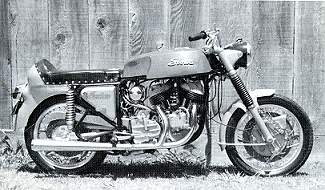
...and some theoretical engine internals to show the crowd at the September 1967 Koln motorcycle show, as his postcard to Max Bubeck relates:
"Our exhibit at Koln stole the show. We had far larger crowds than any other exhibitor. Had 2 mammoths, Indian roadster with Velocette + OHC twin engine - ponybike + papoose, cutaway NSU engine and biggest hit of all was the 500cc dual OHC racing 8 valve .... Will have 650 + 750 cc for US road bikes..."
From the deals made during 1967 tour, the basis of the Clymer range was derived from the offerings of Leo Tartarini, who headed Italjet in Cremona, Italy. He was producing Triumph-powered specials for the local market. As the photos show, a few models were produced, but I have no idea of the number of units manufactured, or whether the California 650 model ever reached the USA:
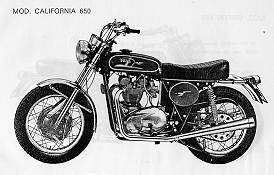 | 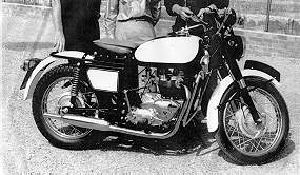 |
 | 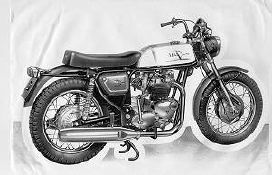 |
However, the Indian prototypes exhibited at the Koln show were a new chassis, only sharing some of the componentry of the Triumph-Italjets.
The OHC twin mentioned by Clymer was a Horex Imperator engine, a combination probably inspired by Munch who was a Horex employee before their closure in 1959. But, by 1967, the engine design was owned by Zundapp, who had last used it in a model called the Citation which had a capacity of 440cc. Supposedly it was at 600cc in this Indian guise, though the bike shown here looks like it has the original cast iron barrel.

This following photo shows a slightly revised version, which sports the later sidecovers and an alloy barrel, which may indicate a bored-out unit with the higher capacity.
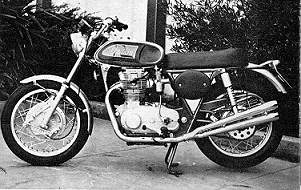
The later prototype Indian Horex
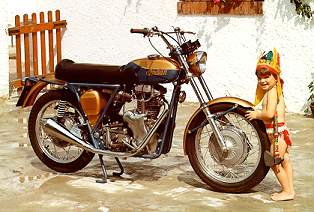
These photos show the Velocette prototype going together at Italjet.
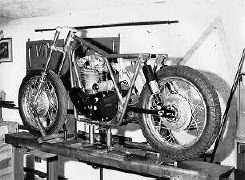 | 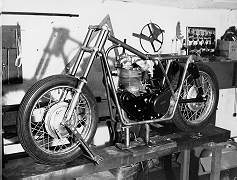 |
Prototype under construction
And not far behind these two models was the promised 750cc road bike - seen below, the first of the Interceptor twins, as tested by the Americans in May 1969...note the different paintwork and brake hubs to the first production examples:

Prototype Clymer Enfield
As well, Clymer experimented with another prototype in 1969, using a Norton engine. According to Mitchell's who attempted to provide the engines to Floyd directly from the Norton factory, the USA distributor Berliner Corporation prevented the sale to Floyd, but not before at least one machine was built in Italy. In 1970, Max Bubeck's son became the owner of this machine, though it has long since passed into obscurity.

Italjet continued to refine their range and produced this Triumph 650 in 1969/1970, and called it the Griffo (Gryphon). It became the standard chassis for the majority of the production Indians. Interestingly, Triumph had a policy of NOT supplying engines to other manufacturers, and I've been told Italjet sidestepped this hurdle by ordering their engines as every number in the spare parts book. Some clever storeman at Triumph was deciding the easiest way to fulfill the order was to send complete engines to Italy....until they worked out what they were being used for.

As can be seen from these various photos of the production Indians, some small variations exist within this second series, for instance, I have seen a few of the bikes sporting the shapely tanks from the earlier style.
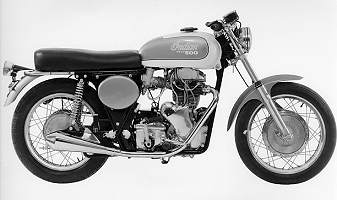
A flat handlebar version - probably made for the English market


All of the Clymers I have seen to date use the white/gold scheme for the Velocettes and powder blue/white for the Enfields. While the majority of cycle parts are standard-for-the era Italian product some small parts have been transferred over from the original bikes. For example, the Velocette and Enfield versions of the Smiths' instruments, and the Enfield's exhaust pipes and centre stand.
The unique parts for these bikes are the frame, tank, seat, sidecovers, guards and instrument brackets. So where in this chronology does this interesting photo fit in? Did Munch experience a moment of panic because he had a whole bunch of Horex motors left over after Floyd died?...and did he contact the Rickman brothers...
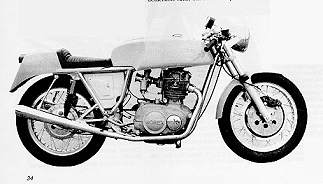
Naturally, I'm keeping a register of engine and frame numbers for all Clymers, so if you can add to this database or provide any information, I'd be only too pleased to hear from you.
I can be contacted on: +61 3 98023898 or by post: 10 Danene Court, Vermont South 3133 Australia
Credits: I am indebted to Ian Abrahams, Max and Lon Bubeck, Pasquale Mesto, and a few owners for all the information herein. Copyright 2001 - Phil Doland
The last word: I suppose I should drop this picture in because it's my father's Munch Mammoth, which is sheer coincidence....





























